
Beatification is a recognition accorded by the Catholic Church of a deceased person's entrance into Heaven and capacity to intercede on behalf of individuals who pray in their name. Beati is the plural form, referring to those who have undergone the process of beatification; they possess the title of "Blessed" before their names and are often referred to in English as "a Blessed" or, plurally, "Blesseds".

Aloysius de Gonzaga was an Italian aristocrat who became a member of the Society of Jesus. While still a student at the Roman College, he died as a result of caring for the victims of a serious epidemic. He was beatified in 1605 and canonized in 1726.

Camillus de Lellis, M.I., was a Roman Catholic priest from Italy who founded the Camillians, a religious order dedicated to the care of the sick. He was beatified by Pope Benedict XIV in the year 1742, and canonized by him four years later in 1746. De Lellis is the patron saint of the sick, hospitals, nurses and physicians. His assistance is also invoked against gambling.

Gerolamo Emiliani, CRS was an Italian humanitarian, founder of the Somaschi Fathers, and is considered a saint by the Catholic Church.

Bernardo Tolomei was an Italian Catholic priest and the founder of the Congregation of the Blessed Virgin of Monte Oliveto. In the Roman Martyrology he is commemorated on August 20, but in the Benedictine calendar his optional memorial is celebrated on the previous day.

Roch, also called Rock in English, was a Majorcan Catholic confessor whose death is commemorated on 16 August and 9 September in Italy; he was especially invoked against the plague. He has the designation of Rollox in Glasgow, Scotland, said to be a corruption of Roch's Loch, which referred to a small loch once near a chapel dedicated to Roch in 1506.

Jean-François Régis, SJ, commonly known as Saint John Francis Regis and Saint Regis, was a French priest of the Society of Jesus, recognized as a saint by the Catholic Church in 1737. A tireless preacher, Regis is best known for his work with at-risk women and orphans.
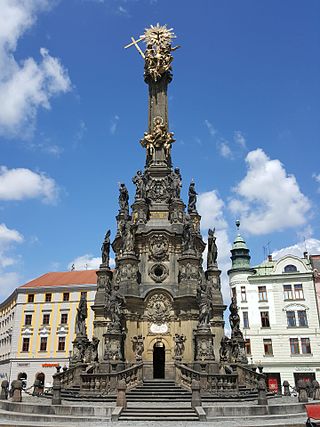
The Holy Trinity Column in Olomouc, in the Czech Republic is a Baroque monument that was built between 1716 and 1754. The main purpose was to celebrate the Catholic Church and faith, partly caused by feeling of gratitude for ending a plague, which struck Moravia between 1713 and 1715. The column was also understood to be an expression of local patriotism, since all artists and master craftsmen working on this monument were Olomouc citizens, and almost all depicted saints were connected with the city of Olomouc in some way.
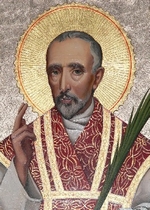
John Southworth was an English Catholic martyr. He is one of the Forty Martyrs of England and Wales.

Rafael Guízar y Valencia was a Mexican bishop of the Roman Catholic Church who was persecuted during the Mexican Revolution. Named Bishop of Xalapa in 1919, he was driven out of his diocese and forced to live the remainder of his life in hiding in Mexico City. Pope Benedict XVI canonized Guízar on 15 October 2006.
In the Catholic Church, a martyr of charity is someone who dies as a result of a charitable act or of administering Christian charity. While a martyr of the faith, which is what is usually meant by the word "martyr", dies through being persecuted for being a Catholic or for being a Christian, a martyr of charity dies through practicing charity motivated by Christianity. This is an unofficial form of martyrdom; when Pope Paul VI beatified Maximilian Kolbe he gave him that honorary title.
During the Spanish Civil War Catholic people faced persecution from the Republican faction of the war, in part due to their support of the nationalists and the recently abolished monarchy. The Catholic Church venerates them as martyrs. More than 6,800 clerics and other Catholic people were killed in what has been dubbed the Red Terror. As of November 2023, 2,127 Spanish martyrs have been beatified; 11 of them being canonized. For some 2,000 additional martyrs, the beatification process is underway

Pierre de Luxembourg was a French Catholic prelate who served as the Bishop of Metz. He was made a cardinal of by an antipope, yet proclaimed "blessed" by the Catholic Church 140 years after his death.

The 498 Spanish Martyrs were victims of the Spanish Civil War beatified by the Roman Catholic Church in October 2007 by Pope Benedict XVI. They originated from many parts of Spain. Their ages ranged from 16 years to 78 years old. Although almost 500 persons, they are a small part of the Martyrs of the Spanish Civil War.
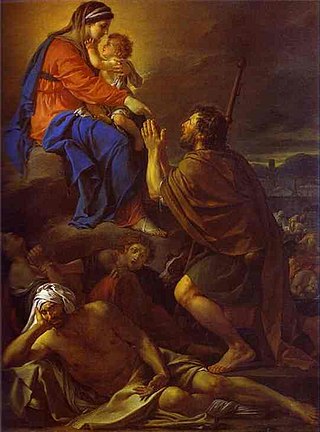
Saint Roch Interceding with the Virgin for the Plague-Stricken is an early religious painting by the French artist Jacques-Louis David. It shows Saint Roch interceding to the Virgin Mary and Christ Child for the plague sufferers shown around him. He painted it in 1780 during his stay at the Villa Medici in Rome after winning first prize for painting in the Prix de Rome and exhibited it at the 1781 Paris Salon on his return to France. While in Rome he was much influenced by the works of Caravaggio, Poussin, Guercino and Lebrun. He was determined not to be seduced by the Italian baroque style, declaring "the Antique will not seduce me, it lacks animation, it does not move". Nevertheless, he filled twelve sketchbooks with drawings while he was in Rome, and he and his studio used them as models for the rest of his life.
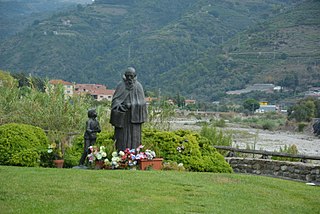
Francesco Maria da Camporosso - born Giovanni Croese - was an Italian Roman Catholic professed religious from the Order of Friars Minor Capuchin. Croese became a beggar in Genoa where he sought alms from people and was at first heckled and assaulted before his reputation for personal holiness spread which prompted people to come and see him.
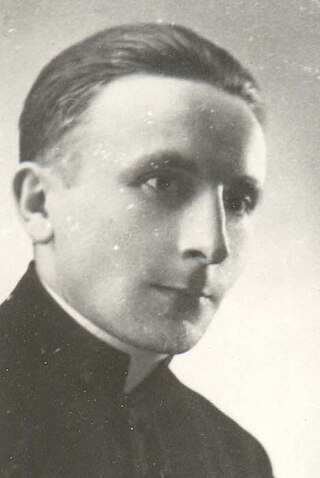
Józef Kowalski was a Polish Roman Catholic priest from the Salesian Society murdered at the Auschwitz concentration camp during World War II. He was beatified in Warsaw on 13 June 1999.

Christ Appointing Saint Roch as Patron Saint of Plague Victims or The Plague Victims is a 1623–1626 altarpiece by Peter Paul Rubens. It is located in the Sint-Martinuskerk in Aalst, Belgium and depicts Saint Roch.
Juan Grande Román, OH was a Spanish Roman Catholic who was a professed religious of the Hospitallers of Saint John of God. He adopted the name of "John the Sinner" and he died of the plague after he tended to those who suffered from it.

Lorenzo da Ripafratta was an Italian Roman Catholic professed religious from the Order of Preachers. He was born to nobles in Pisa and served as a novice master in Cortona in the latter half of his career while distinguishing himself in aiding the ill during times of the plague in both Pistoia and Fabriano.
















